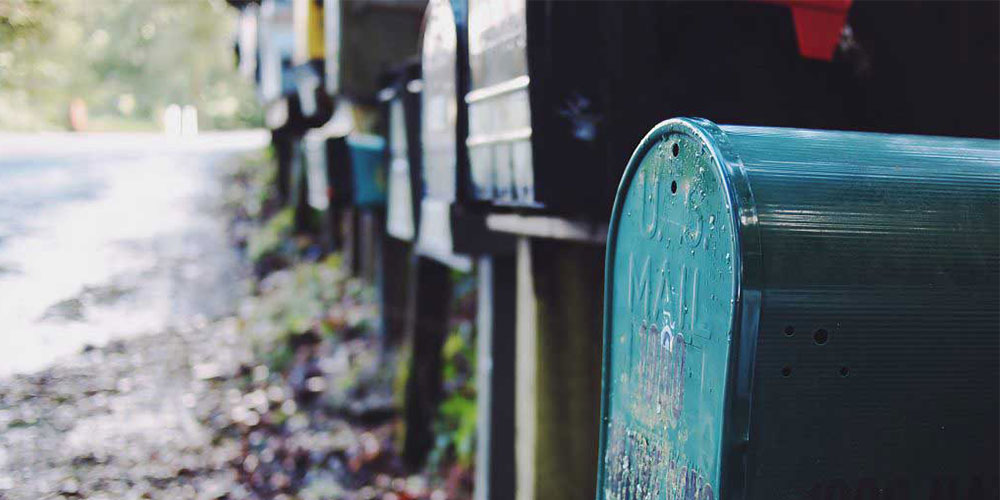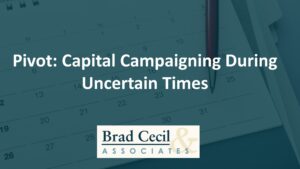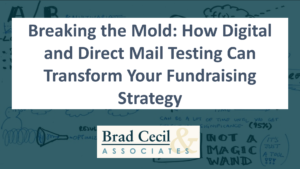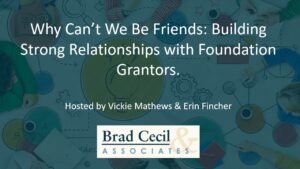DOES DIRECT MAIL STILL WORK
When it comes to communicating with donors – both current and prospective – it’s hard to know the best course of action to take to produce sustainable results. Although studies can tell us about the average donor’s age, demographic and income level, the fact remains that everyone is different and therefore may respond in various ways to different messages. So what’s the best way to communicate with the people who care about your organization?
Direct mail is a time-tested, targeted form of communication between your organization and your donors. Though it’s true that electronic communication is becoming more widely-used in an increasingly web-centric world, direct mail is still the most effective way to communicate with a large, broad base of people.
As you’ll read in the following pages, direct mail is not only an excellent vehicle for presenting your organization’s unique opportunities, it’s useful for segmenting your communication, finding new support, and, because it’s so easy to tailor your messages specifically to your donors, producing dramatic results.
COMPONENTS OF AN EFFECTIVE FUNDRAISING LETTER
So how do you make a direct mail package stand out from bills and junk mail? How do you compel donors to open your mail, read it, and most importantly, respond to it?
An effective fundraising letter has three important components:
First, it’s an appeal from one person to another. Every direct marketing piece you send, whether to prospective or current donors, should come from one person: the president or executive director. Donors want to feel like they’re receiving a letter from a person who recognizes and understands their philanthropic interests. Signing letters with different staff members’ names can be confusing and makes the appeal seem less personal. And the more personal the letter is, the better.
An effective fundraising letter also describes an opportunity for the recipient to meet personal needs by supporting a worthy charitable aim. The act of giving to a charitable organization like yours can be a deeply personal decision – a decision that satisfies one’s personal desire to give back to the community or to help those in need while filling the needs of your organization and the people it serves. A great fundraising letter must appeal to the donor’s emotions and show her how her support makes a difference, so use real stories of people who have been impacted by your organization’s work – and never pass up an opportunity to affirm donors for their involvement.
Lastly, an effective fundraising letter invites the recipient to take specific and immediate action. Once you’ve established the need, tell the recipient how she can help. Ask her for specific gift amounts based on her previous giving history, and then tell her what each amount will provide. Convey urgency and provide deadlines if needed. Remember: people won’t give unless they are asked.
Carrier Envelope
Though it might surprise you, the letter isn’t the most important part of an effective direct mail appeal. That’s because the letter isn’t the first thing the recipient sees – the carrier envelope is.
Carrier envelopes can come in all shapes and sizes. A #10 standard envelope is the most commonly used size, but they can also be smaller (A6 or A7 to fit an executive size package) or larger (6” x 9” to fit a letter-size package folded in half) in order to stand out from the recipient’s pile of mail – which usually contains several #10 envelopes.
Since the carrier is your one chance to get the recipient to open the package, it’s important to have either a compelling teaser or graphic image – or both. Here are some examples:


Laser-print the names and addresses of your upper donors onto closed-face envelopes since they represent a smaller portion of your file – then mail them first-class with a stamp for an added personal touch. Use windowed envelopes for everyone else in your file, and mail them third-class with nonprofit postage.
Reply Device & Reply Envelope
A personalized reply device, complete with graduated gift amounts based on the donor’s giving history, is another essential component of an effective direct mail package. It’s also important to include a reply envelope, pre-printed with your address, for the donor’s convenience. By providing the donor with an easy opportunity to respond, you increase your chances for the results you desire.
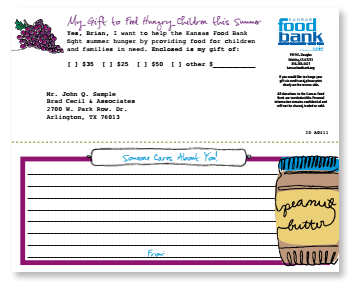
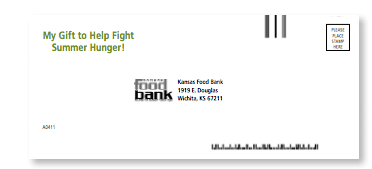
Once you receive a gift in response to a direct mail appeal, send a thank-you note with a reply device and envelope within 48 hours. Don’t miss a single opportunity to affirm your donors for their generosity and their willingness to participate in the work of your organization!
IDENTIFYING DONOR RELATIONSHIPS THROUGH DIRECT MAIL
Direct mail produces dramatic results – but one of the keys to producing these results is proper segmentation. Segmentation is the process of analyzing donor data according to giving history and placing them into different groups. Using criteria such as the donor’s average gift and frequency of giving, you can determine which mailings to send them and what their mailings should look like.
HERE’S A SAMPLE SEGMENTATION STRATEGY:
Active Donors (largest gift 0-24 months)
Upper Donors (usually mail first class with a closed-face envelope, hand-matched)
- $1,000
- $500 – 999.99
- $250 – 499.99
Lower Donors (usually mail third class with a window envelope)
- $100 – 249.99
- $50 – 99.99
- $25 – 49.99
- $15 – 24.99
- $10 – 14.99
- $.01 – 9.99
Acquisition Donors (first gift 0-12 months)
- New donors should be segmented separately
- 50 percent will not give a second gift
- Archive after one year
Lapsed Donors
- Mail selectively
- Treat as acquisition donors
Non Donors
- Save your money – test for acquisition
Segmenting your data allows you to get the most accurate feel for how your donors respond to your direct mail – and the more you know about your donors, the better able you are to tailor your communication to them, producing even greater results.
Segmentation also allows for the development of special giving groups – exclusive groups of supporters who either give frequently throughout the year or make a one-time substantial gift. Once you’ve identified these special supporters, you can personalize your mailings to recognize their unique generosity, further affirming them for their involvement in your work.
You’ll find this strategy will quickly become useful for identifying and cultivating major donor relationships. Your major donors are your organization’s top 50 or 100 donors – find out who they are, develop a plan to cultivate them individually and connect them to each other. Direct mail is a launching pad for these essential relationships, so don’t take this communication for granted!
WHAT’S NEXT?
So what can you do to jump-start the process of increasing your direct mail income? Though sustainable results take time, here are some practical steps you can take now to give your development program a boost:
- Segment your file – spend money in the right places, save money in the right places, and test elements of your best producing packages as often as possible.
- Incorporate graduated ask amounts in your reply devices – give donors a chance to give more than they would have originally planned.
- Send a thank-you note within 48 hours – don’t ever miss a chance to affirm your donors! Remember to include a reply device and envelope.
- Don’t forget that direct mail is a pipeline for identifying and cultivating major donors – watch for your top 50 – 100 donors and develop a plan to cultivate those essential relationships.
- Remember that people won’t give unless they are asked!

